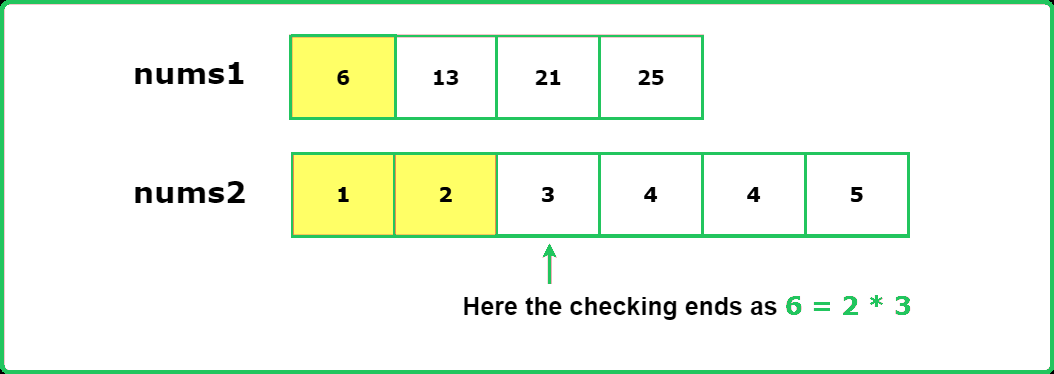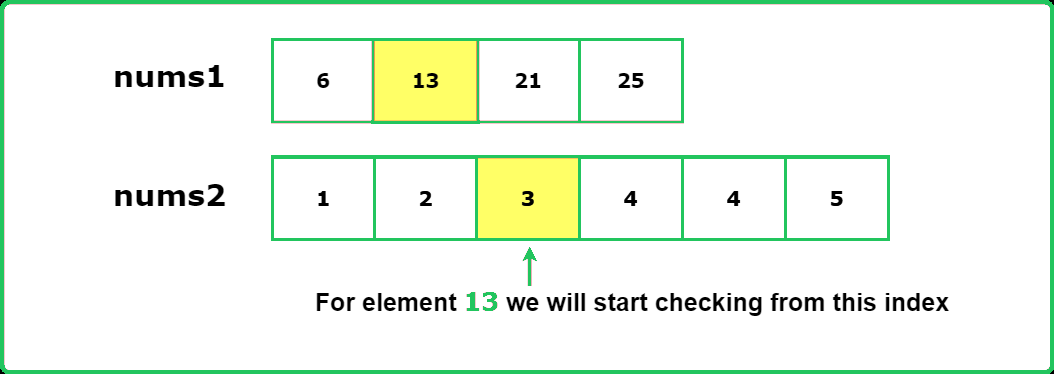12345678910111213141516171819202122232425262728293031323334353637383940414243444546474849505152535455565758
#include <bits/stdc++.h>
using namespace std;
class Solution {
public:
/* Function to count reverse
pairs where a[i] > 2 * a[j]*/
int reversePairs(vector<int>& nums) {
int n = nums.size();
return team(nums, n);
}
private:
/* Merge function to merge two
sorted halves and count reverse pairs*/
void merge(vector<int>& arr, int low, int mid, int high) {
// temporary array
vector<int> temp;
// starting index of left half of arr
int left = low;
// starting index of right half of arr
int right = mid + 1;
// Merge and count reverse pairs
while (left <= mid && right <= high) {
if (arr[left] <= arr[right]) {
temp.push_back(arr[left]);
left++;
}
else {
temp.push_back(arr[right]);
right++;
}
}
// Copy remaining elements from left half
while (left <= mid) {
temp.push_back(arr[left]);
left++;
}
// Copy remaining elements from right half
while (right <= high) {
temp.push_back(arr[right]);
right++;
}
// Transfer sorted elements from temp to arr
for (int i = low; i <= high; i++) {
arr[i] = temp[i - low];
}
}
private:
//Function to count reverse pairs
int countPairs(vector<int> &arr, int low, int mid, int high) {
int right = mid + 1;
int cnt = 0;
for (int i = low; i <= mid; i++) {
/*while right is less than equal to high
and arr[i] is greater than 2 * arr[right]
then increment right by 1*/
while (right <= high && arr[i] > 2 * arr[right]) right++;
cnt += (right - (mid + 1));
}
//Return the count
return cnt;
}
private:
/* Merge sort function to sort the
array and count reverse pairs*/
int mergeSort(vector<int>& arr, int low, int high) {
int cnt = 0;
if(low >= high){
return cnt;
}
int mid = low + (high - low) / 2;
// Sort left half
cnt += mergeSort(arr, low, mid);
// Sort right half
cnt += mergeSort(arr, mid + 1, high);
cnt += countPairs(arr, low, mid, high);
// Merge and count pairs
merge(arr, low, mid, high);
//Return the count of reverse pairs
return cnt;
}
private:
int team(vector <int> & skill, int n){
return mergeSort(skill, 0, n - 1);
}
};
int main() {
vector<int> nums = {6, 4, 1, 2, 7};
//Create an instance of Solution class
Solution sol;
int cnt = sol.reversePairs(nums);
//Print the count of reverse pairs
cout << "The number of reverse pairs is: " << cnt << endl;
return 0;
}
123456789101112131415161718192021222324252627282930313233343536373839404142434445464748495051525354555657585960616263646566676869707172737475767778798081828384858687888990919293949596979899100101102103104105106107108109110
import java.util.*;
class Solution {
/* Function to count reverse
pairs where a[i] > 2 * a[j]*/
public int reversePairs(int[] nums) {
int n = nums.length;
return team(nums, n);
}
/* Merge function to merge two
sorted halves and count reverse pairs*/
private void merge(int[] arr, int low, int mid, int high) {
// temporary array
List<Integer> temp = new ArrayList<>();
// starting index of left half of arr
int left = low;
// starting index of right half of arr
int right = mid + 1;
// Merge and count reverse pairs
while (left <= mid && right <= high) {
if (arr[left] <= arr[right]) {
temp.add(arr[left]);
left++;
} else {
temp.add(arr[right]);
right++;
}
}
// Copy remaining elements from left half
while (left <= mid) {
temp.add(arr[left]);
left++;
}
// Copy remaining elements from right half
while (right <= high) {
temp.add(arr[right]);
right++;
}
// Transfer sorted elements from temp to arr
for (int i = low; i <= high; i++) {
arr[i] = temp.get(i - low);
}
}
// Function to count reverse pairs
private int countPairs(int[] arr, int low, int mid, int high) {
int right = mid + 1;
int cnt = 0;
for (int i = low; i <= mid; i++) {
/*while right is less than equal to high and arr[i]
is greater than 2 * arr[right] then increment right by 1*/
while (right <= high && arr[i] > 2 * arr[right]) right++;
cnt += (right - (mid + 1));
}
//Return the count
return cnt;
}
/* Merge sort function to sort the
array and count reverse pairs*/
private int mergeSort(int[] arr, int low, int high) {
int cnt = 0;
if (low >= high) {
return cnt;
}
int mid = low + (high - low) / 2;
// Sort left half
cnt += mergeSort(arr, low, mid);
// Sort right half
cnt += mergeSort(arr, mid + 1, high);
// Merge and count pairs
cnt += countPairs(arr, low, mid, high);
merge(arr, low, mid, high);
//Return the count of reverse pairs
return cnt;
}
private int team(int[] skill, int n) {
return mergeSort(skill, 0, n - 1);
}
public static void main(String[] args) {
int[] nums = {6, 4, 1, 2, 7};
// Create an instance of Solution class
Solution sol = new Solution();
int cnt = sol.reversePairs(nums);
// Print the count of reverse pairs
System.out.println("The number of reverse pairs is: " + cnt);
}
}
12345678910111213141516171819202122232425262728293031323334353637383940414243444546474849505152535455565758596061626364656667686970717273747576777879808182838485868788899091929394959697
from typing import List
class Solution:
""" Function to count reverse
pairs where a[i] > 2 * a[j]"""
def reversePairs(self, nums: List[int]) -> int:
n = len(nums)
return self.team(nums, n)
""" Merge function to merge two
sorted halves and count reverse pairs"""
def merge(self, arr: List[int], low: int, mid: int, high: int) -> None:
# temporary array
temp = []
# starting index of left half of arr
left = low
# starting index of right half of arr
right = mid + 1
# Merge and count reverse pairs
while left <= mid and right <= high:
if arr[left] <= arr[right]:
temp.append(arr[left])
left += 1
else:
temp.append(arr[right])
right += 1
# Copy remaining elements from left half
while left <= mid:
temp.append(arr[left])
left += 1
# Copy remaining elements from right half
while right <= high:
temp.append(arr[right])
right += 1
# Transfer sorted elements from temp to arr
for i in range(low, high + 1):
arr[i] = temp[i - low]
# Function to count reverse pairs
def countPairs(self, arr: List[int], low: int, mid: int, high: int) -> int:
right = mid + 1
cnt = 0
for i in range(low, mid + 1):
"""while right is less than equal to high and arr[i]
is greater than 2 * arr[right] then increment right by 1"""
while right <= high and arr[i] > 2 * arr[right]:
right += 1
cnt += (right - (mid + 1))
# Return the count
return cnt
""" Merge sort function to sort the
array and count reverse pairs"""
def mergeSort(self, arr: List[int], low: int, high: int) -> int:
cnt = 0
if low >= high:
return cnt
mid = (low + high) // 2
# Sort left half
cnt += self.mergeSort(arr, low, mid)
# Sort right half
cnt += self.mergeSort(arr, mid + 1, high)
# Merge and count pairs
cnt += self.countPairs(arr, low, mid, high)
self.merge(arr, low, mid, high)
# Return the count of reverse pairs
return cnt
def team(self, skill: List[int], n: int) -> int:
return self.mergeSort(skill, 0, n - 1)
if __name__ == "__main__":
nums = [6, 4, 1, 2, 7]
# Create an instance of the Solution class
sol = Solution()
cnt = sol.reversePairs(nums)
# Print the count of reverse pairs
print("The number of reverse pairs is:", cnt)
123456789101112131415161718192021222324252627282930313233343536373839404142434445464748495051525354555657585960616263646566676869707172737475767778798081828384858687888990919293949596979899100101102103104105106107108109110
class Solution {
/* Function to count reverse
pairs where a[i] > 2 * a[j]*/
reversePairs(nums) {
let n = nums.length;
return this.team(nums, n);
}
/* Merge function to merge two
sorted halves and count reverse pairs*/
merge(arr, low, mid, high) {
// temporary array
let temp = [];
// starting index of left half of arr
let left = low;
// starting index of right half of arr
let right = mid + 1;
// Merge and count reverse pairs
while (left <= mid && right <= high) {
if (arr[left] <= arr[right]) {
temp.push(arr[left]);
left++;
} else {
temp.push(arr[right]);
right++;
}
}
// Copy remaining elements from left half
while (left <= mid) {
temp.push(arr[left]);
left++;
}
// Copy remaining elements from right half
while (right <= high) {
temp.push(arr[right]);
right++;
}
// Transfer sorted elements from temp to arr
for (let i = low; i <= high; i++) {
arr[i] = temp[i - low];
}
}
// Function to count reverse pairs
countPairs(arr, low, mid, high) {
let right = mid + 1;
let cnt = 0;
for (let i = low; i <= mid; i++) {
/*while right is less than equal to high and arr[i]
is greater than 2 * arr[right] then increment right by 1*/
while (right <= high && arr[i] > 2 * arr[right]) right++;
cnt += (right - (mid + 1));
}
//Return the count
return cnt;
}
/* Merge sort function to sort the
array and count reverse pairs*/
mergeSort(arr, low, high) {
let cnt = 0;
if (low >= high) {
return cnt;
}
let mid = Math.floor((low + high) / 2);
// Sort left half
cnt += this.mergeSort(arr, low, mid);
// Sort right half
cnt += this.mergeSort(arr, mid + 1, high);
// Merge and count pairs
cnt += this.countPairs(arr, low, mid, high);
this.merge(arr, low, mid, high);
//Return the count of reverse pairs
return cnt;
}
team(skill, n) {
return this.mergeSort(skill, 0, n - 1);
}
static main() {
const nums = [6, 4, 1, 2, 7];
// Create an instance of Solution class
let sol = new Solution();
let cnt = sol.reversePairs(nums);
// Print the count of reverse pairs
console.log("The number of reverse pairs is: " + cnt);
}
}
// Call the main function to test the Solution class
Solution.main();

